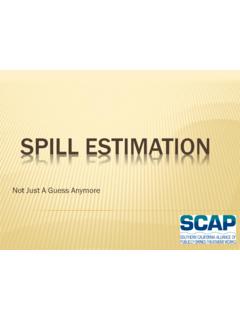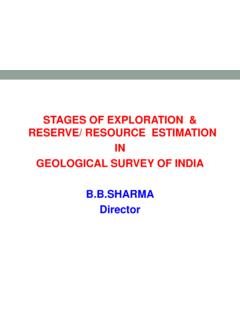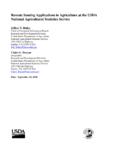Transcription of Resource Use Efficiency and Rice Production in …
1 International Review of Social Sciences and Humanities Vol. 3, No. 1 (2012), pp. 108-116 ISSN 2248-9010 (Online), ISSN 2250-0715 (Print) Resource Use Efficiency and Rice Production in Guma Local Government Area of Benue State: An Application of Stochastic Frontier Production Function Isa. J. Okpe (Corresponding Author) Department of Economics, Benue State University, PMB 102119, Makurdi, Postal Code 970001, Nigeria E-mail: Cyprian Clement Abur Department of Economics, Benue State University, PMB 102119, Makurdi, Postal Code 970001, Nigeria E-mail: Sam.
2 O. Ominyi Department of Economics, Benue State University, PMB 102119, Makurdi, Postal Code 970001, Nigeria E-mail: (Received: 30-12-11 / Accepted: 17-2-12) Abstract This study assesses Resource use Efficiency and Rice Production in Guma Local Government Area of Benue state. To achieve this Primary data were used. The analytical tools include gross margin and stochastic frontier Production function applied on a cross-sectional data of 620 sampled randomly from rice farmers during 2011 farming season. The results indicate that both yield and profit of small and medium scale farmers remained small, when compared with large scale farmers.
3 Also the results from Maximum Likelihood Estimation shows that all estimated coefficients among various farm operation indicates positive sign which implies that increase in quantities of these inputs would result in increase output of rice. The results obtained from the Inefficiency model, indicates the Resource use in rice Production in the study area was not fully utilized in all the categories of farms examined, although farmers were generally relatively efficient, they still have room to increase the Efficiency of their farming activities to 65%, 53% and 46% for small, medium and large scale farm respectively to close the Efficiency gap from the optimum (100%).
4 The technical returns to scales measured by the sum of the elasticity of all significant factors showed that small and large scale exhibited increasing return to scale while medium scale farms demonstrated decreasing return to scale, but for pooled observation it depict constant return to scale. The study recommended that farm inputs should be made available to farmers at highly subsidized rates and makes them available timely, through adequate supply and efficient distribution. Keywords: Efficiency of Resource -use, Food Crisis, Elasticity of Production , Maximum Likelihood Estimates, Return to Scale, Stochastic Frontier Production Function.
5 International Review of Social Sciences and Humanities, Vol. 3, No. 1 (2012), 108-116 109 Introduction Nigeria s socio-economic history and development has been very closely tied to its agricultural sector (Egbuna, 2008). The country is blessed with varied climatic zones, enormous resources, and has the potential of producing, processing, marketing and exporting different agricultural commodities. In Nigeria, before and immediately after independence, agriculture was the mainstay of the economy. However, its contribution to the economy have been declining since the oil boom of 1970 contribution of agriculture to Gross Domestic Product (GDP) which was 65% on the average in the 60 s dropped to between 1976 and 1980 even though it rose to about in the year 2005 (CBN, 2006).
6 This trend of agricultural contribution to GDP is not consistent with the expected role of agriculture as the economy develops. Thus Guma Local Government Area of Benue State which is naturally endowed with both material and human resources has a great potential to produce and export various agricultural products, rice inclusive. It is therefore unfortunate that the opportunities available in the agricultural sector remain untapped because most available land is uncultivated and all year farming have not been carried out which shows that agricultural activities can all be carried out during the raining season. Rice is widely consumed and there is hardly any country in the world where it is not utilized in one form or the other.
7 In Nigeria, rice is one of the few food items whose consumption has no cultural, religious, ethnic or geographical boundary (Udoh, 2003). But unfortunately, the cultivation and Production of this highly prized and very important food crop is dwindling. One way these Resource -poor farmers, who contribute more than 90% of agricultural output in Nigeria (FMA and WR, 2008), can achieve sustainability in agricultural Production within the limit of existing Resource base will be a more efficient usage of resources. Thus, the main objective of this study is to identify any gaps that may exist in the current level of resources employed by rice farmers through the use of the Stochastic Frontier Production Function (SFPF) in the estimation of the Efficiency of Resource -use and Production elasticities among rice farmers in the study area.
8 These gaps would serve as intervention points that would assist in enhancing the productivity and profitability of the farmers, as well as encouraging them to beef up their current level of output so as to bridge the current shortfalls in rice Production . To cope with the predominant menace of poverty and unemployment in Guma LGA, resources use efficient is a prerequisite for optimum farm Production since inefficiency in Resource use, can distort food availability and security. For these reasons, the pertinent questions concerning rice farming therefore becomes; are these resources used productively? How statistically significant are these resources (inputs) to rice output?
9 And if these inputs are available, are they technically efficient in their use in Guma Local Government Area where majority of the farmers are Resource -poor? Theoretical Framework and Literature Review Three types of Efficiency are identified in the literature. These are technical Efficiency , allocative Efficiency and overall or economic Efficiency (Farrell, 1957; Olayide and Heady, 1982). Technical Efficiency is the ability of a farm to produce a given level of output with minimum quantity of inputs under a given technology. Allocative Efficiency is a measure of the degree of success in achieving the best combination of different inputs in producing a specific level of output considering the relative prices of these inputs.
10 Economic Efficiency is a product of technical and allocative Efficiency (Olayide and Heady, 1982). In one sense, the Efficiency of a farm is its success in producing as large an amount of output as possible from given sets of inputs. In Farrell (1957) frame work, economic Efficiency (EE) is an overall performance measure and is equal to the product of TE and AE (that is EE= TE * AE). From his analysis, a farm that is technically efficient in Resource use operates on a Production frontier, while a technically inefficient farm in resources use operates below the Production frontier. Hence, the position of individual farm relative to the frontier could be influenced by factors ranging from climatic, socio-economic and marketing etc.









